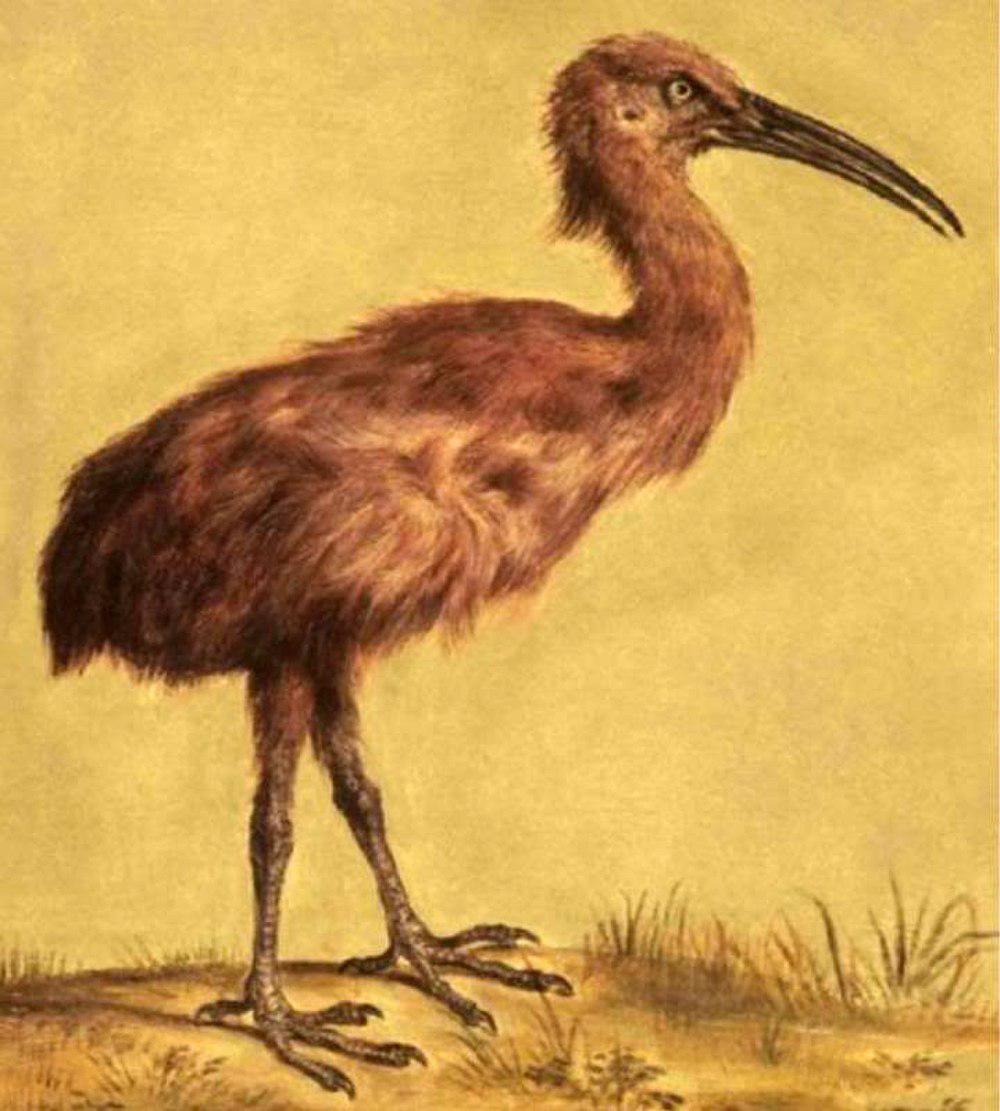Red Rail / Aphanapteryx bonasia

Red Rail
SCI Name:
Protonym: Apterornis bonasia Rev.Zool. 11 p.294
Taxonomy: Gruiformes / Rallidae / Aphanapteryx
Taxonomy Code: redrai1
Type Locality:
Author: Sélys-Longchamps
Publish Year: 1848
IUCN Status: Extinct
DEFINITIONS
APHANAPTERYX
‡ (Rallidae; † Red Rail A. bonasia) Gr. αφανης aphanēs unseen, invisible < negative prefix α- a-; φαινω phainō to show; πτερυξ pterux, πτερυγος pterugos wing; the Red Rail, known only from contemporary accounts and illustrations and subfossil remains, had short, useless wings and was flightless; "Aphanapteryx n. g. Schnabel verlängert, ziemlich gekrümmt, nicht abgesetzt. Nasenlöcher an der Wurzel unbedeckt? Daumenzehe der nackten hühner-artigen Beine fast eben, mässig lang. Läufe (anscheinend) geschildert. Flügel ganz verkümmert, keine Steuerfedern. Aphanapteryx Imperialis n. sp." (von Frauenfeld 1868); "Aphanapteryx Frauenfeld, N. Abbild. Dronte, p. 6, 1868. Type by monotypy, A. imperialis Frauenfeld = Apterornis bonasia Sélys." (W. Sclater, 1924, Syst. Av. Aethiop., I, p. 102).
bonasia
● Olson in Ripley 1977, wrote of the extinct Red Rail, “Here bonasia is evidently intended to refer to Tetrastes bonasia, the Eurasian Hazel Hen, since in early accounts the Mauritian rail was referred to by vernacular names [e.g. “Gellinote”] elsewhere applied to the grouse. The derivation of bonasia itself is uncertain and more than one interpretation has been offered, both for this word and for Bonasa...The most common explanation is that these words are derived from Greek bonasos, Latin bonasus (a bull) ...Choate (1973) has proposed that Bonasa may be derived from Latin bonum (good) and assum (a roast). Mr Farrand offers two additional suggestions. The first is that the original authors did intend an allusion to Greek bonasos, but that they meant to suggest the birds’ timidity, since the Greek word refers specifically to a mythical bull... whose horns were unfit for fighting and thus was obliged to save itself by fleeing ignominiously. Conversely, he suggests the possibility that the allusion may be to the well-known tameness of certain grouse, the words Bonasa and bonasia being latinized forms of French bonasse (simple-minded or good-natured)” (‡Aphanapteryx).
● Mod. L. bonasa or bonasia Hazel Hen < Italian name Bonasia for the Hazel Hen < L. bonasus type of maned bull < Gr. βονασος bonasos bison, bull, aurochs; "91. TETRAO. ... Bonasia. 7. T. pedibus hirsutis, rectricibus cinereis punctis nigris fascia nigra: exceptis intermediis duabus. Fn. svec. 170. Gallina corylorum. Gesn. av. 229. Aldr. orn. l. 13. c. 11. Will. orn. 126. t. 21. Raj. av. 55. Habitat in Europæ Coryletis. Fistula dulce canit volucrem dum decipit auceps." (Linnaeus 1758); "TETRAO BONASIA. ... Caro omnium sapidissima *). *) Unde nomen Bonasia, quasi bona assa." (Nilsson 1817 (Björn Bergenholtz in litt.)) (Tetrastes).
Bonasia
• (Phasianidae; syn. Bonasa † Ruffed Grouse B. umbellus) "SUBGENUS I BONASIA. Tetrao, Vieill, Coqs de bruyères, Cuv. Bonasa, Stephens. Lower portion of the tarsus, and toes naked. Not varying much with the seasons. Lives in dense forests of different kinds of trees. 205. TETRAO UMBELLUS, L. ... Ruffed Grous, Tetrao umbellus, Wils. Am. Orn. vi. p. 45. pl. 49. male." (Bonaparte 1828); "Bonasia Bonaparte, 1828, Annals Lyceum Nat. Hist. New York, II, p. 126. Type, by monotypy, Tetrao umbellus Linnaeus, 1766." (JAJ 2020).
• (Phasianidae; syn. Tetrastes † Hazel Hen T. bonasia) "III. Bonasia, a new division, of which we propose Tetrao bonasia, L. as the type, in which only the upper portion of the tarsus is feathered." (Bonaparte 1828); "Bonasia Bonaparte, 1828, American Ornithology, III, p. 28. Type, by original designation and tautonymy, Tetrao bonasia Linnaeus, 1758." (JAJ 2020).
UPPERCASE: current genus
Uppercase first letter: generic synonym
● and ● See: generic homonyms
lowercase: species and subspecies
●: early names, variants, mispellings
‡: extinct
†: type species
Gr.: ancient Greek
L.: Latin
<: derived from
syn: synonym of
/: separates historical and modern geographic names
ex: based on
TL: type locality
OD: original diagnosis (genus) or original description (species)












